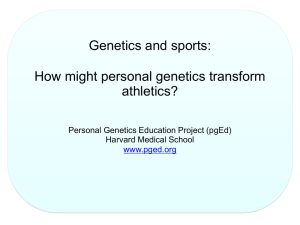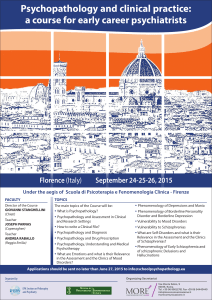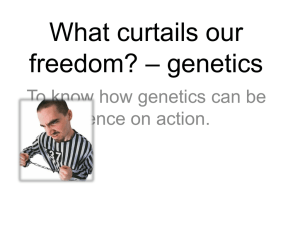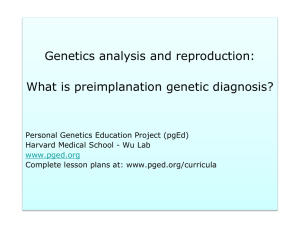Ch03 - Myweb @ CW Post
advertisement
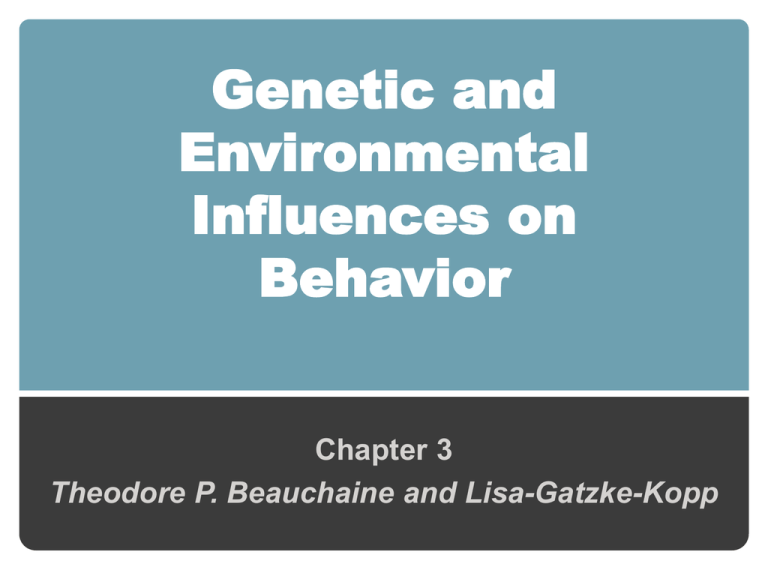
Genetic and Environmental Influences on Behavior Chapter 3 Theodore P. Beauchaine and Lisa-Gatzke-Kopp HISTORICAL CONTEXT Early causes of psychopathology focused on nature versus nurture. Due to lack of formal scientific methods and technological and methodological tools it was difficult to effectively parse the relative contributions of heritable and environmental influences on behavior. A growing body of research in the last 10 to 15 years indicate that Gene × Environment interactions may be more important in determining behavior then either factor alone (Moffitt, Caspi, & Rutter, 2006; Rutter, 2007). THE DEVELOPMENTAL PSYCHOPATHOLOGY PERSPECTIVE An approach for studying the emergence of behavior disorders that emerged in the past 30 years. Analysis refer to different systems through which a psychopathological trait is expressed, spanning genes to behavior to broad cultural factors. Integrates the strengths of numerous other disciplines, including psychiatric genetics, child clinical psychology, child psychiatry, developmental psychology, epidemiology, and clinical neuroscience. TERMINOLOGICAL AND CONCEPTUAL ISSUES Genotypes, Phenotypes, and Endophenotypes Genotype • Refers to the structural composition of the specific genes within an individual. • Some genetic variants give rise to individual differences in the synthesis, reuptake, and catalysis of neurotransmitters. When functionally compromised, these neurotransmitter systems may confer vulnerability to mood disorders, impulse control problems, and asociality. • Both genes and environment are implicated in the expression of almost all forms of psychopathology. • There are no genes for particular behaviors or disorders. • Environments can alter gene expression. • Many people who are genetically vulnerable never develop mental illness. TERMINOLOGICAL AND CONCEPTUAL ISSUES Phenotype • Refers to the observable characteristics—both physical and behavioral—that result from the interplay between an organism’s genes and the environment. • Most forms of psychopatholoy are polygenetic traits and are influenced by many genes. • Multiple genetic influences allow for many opportunities for both gene-gene interactions and environmental regulation of gene expression. TERMINOLOGICAL AND CONCEPTUAL ISSUES Endophenotype • Are a special case of phenotype, as they are measurable physical, physiological, or behavioral traits; the difference is that they are closer to the functional output of the gene in question. • Endophenotypes are valuable to psychiatric geneticists in their attempts to identify: • Specific alleles associated with psychopathology • Genetically vulnerable individuals who have not yet developed psychopathology • To qualify an endophenotype, a biomarker must: • • • • • • Segregate with illness in the general population Be heritable Be state independent Co-segregate with disorder within families Be present at higher rates in affected families than in the general population Be measured reliably and specifically PSYCHIATRIC GENETICS Objectives of psychiatric genetics: Behavioral genetics research: To parse variability in behavioral traits within populations into portions accounted for by (a) heritable mechanisms, (b) environmental mechanisms, and sometimes (c) Gene × Environment (G × E) interactions. Molecular genetics research: To identify specific alleles that confer vulnerability to psychopathology. PSYCHIATRIC GENETICS Behavioral Genetics Additive Gene Effects • Encompass all sources of variance in a behavioral trait that are accounted for by heritable mechanisms within a population. • Maternal programming: When genes are activated (“turned on”) among offspring only when their mothers are exposed to particular environments, often prenatally (Rutter et al., 2006). • Such effects may increase risk for or protect against the emergence of psychopathology. These effects are not purely genetic, yet they are often subsumed within the additive genetic component in behavioral genetics studies. PSYCHIATRIC GENETICS Behavioral Genetics Shared and Nonshared Environmental Effects • ACE model • A is the heritable effects, C is the shared environmental effects, and nonshared environmental effects are denoted E. • When squared, each term signifies a proportion of variance in behavior accounted for. In theory, these sources sum to 1.0, accounting for all variance in a particular trait (A2 + C2 + E2 = 1.0). • Research is accomplished through twin, family, and adoption studies using the ACE model. Psychiatric Genetics Molecular Genetics Linkage studies: Scan broad sections of the genome, and require large samples of families with two or more children affected by psychopathology. Genetic data are collected from family members, and searches are conducted for genetic markers with known chromosomal locations. Association studies: Begin with a specific candidate gene that is suspected of conferring risk for a psychiatric disorder. Allelic frequencies of this gene are then compared among those with and without the disorder. Results are expressed as odds ratios, which compare the likelihood that a person with a candidate polymorphism has a target disorder with the likelihood that a person without a candidate polymorphism has a target disorder. Psychiatric Genetics Heterogeneity of Phenotypes Presents obstacles to identifying genetic substrates of psychopathology: • Criteria used for symptom assessment and participant selection often differ across studies. • Equifinality: The same or similar symptoms can develop through different etiological pathways. • Diagnostic syndromes are highly complex and are often defined by a compilation of symptoms. PSYCHIATRIC GENETICS Gene-Environment Interaction (G × E) Refers to situations in which environments moderate the effects of genes on behavior, or in which genes moderate the effects of environments on behavior. Gene-Environment Correlation (rGE) Refers to situations in which heritable traits of parents affect their child’s exposure to adverse environments or heritable traits of children affect their own exposure to adverse environments. • Active rGE occurs when a child’s heritable vulnerabilities influence his or her selection of environments. • Evocative rGE occurs when genetically influenced behaviors elicit reactions from others that interact with and exacerbate existing vulnerabilities. • Passive rGE occurs when genetic factors that are common to both a parent and child influence parenting behaviors or home environments more generally. Psychiatric Genetics Epigenetics Refers to changes in gene expression that result from alterations in DNA structure and are mediated primarily by environmentally triggered methylation processes (i.e., conversion of a cytosine to 5-methylcytosine). Difficult to research epigrnetic changes in gene expression humans because it requires random assignment of groups to different rearing environments (e.g., impoverished versus enriched) (Rutter, 2007). Research on the indirect evidence of epigenetic processes can be done by measuring methylation of target genes. GENETICS OF COMORBIDITY Homotypic comorbidity refers to the co-occurrence of multiple externalizing disorders within an individual or the co-occurrence of multiple internalizing disorders within an individual. Heterotypic comorbidity refers to the co- occurrence of at least one externalizing disorder and at least one internalizing disorder within an individual (e.g., CD and depression). GENETICS OF COMORBIDITY Behavioral Genetics of Comorbidity Homotypic comorbidity: Indicates most disorders within the externalizing spectrum share a common heritable vulnerability, with similar findings reported for disorders within the internalizing spectrum. Heterotypic comorbidity: Suggest common heritability across internalizing and externalizing disorders. Molecular Genetics of Comorbidity Homotypic comorbidity: Central dopamine (DA) dysfunction may account for much of the shared vulnerability for externalizing disorders and vulnerability for internalizing disorders is conferred largely through trait anxiety, which has been linked closely with serotonin neurotransmission. Heterotypic comorbidity: Deficiencies in DA-mediated reward circuitry are moderated by other biologically influenced traits to affect behavior. Genetics of Comorbidity Symptom overlap for depression and conduct disorder Depression CD Reward Dysfunction High Inhibition • anhedonia • irritability • low motivation Low Inhibition Genetics of Continuity Homotypic continuity: Describes the unfolding of a single class of behavioral/emotional disturbance over time (e.g., aggression). Heterotypic continuity: Refers to the sequential development of different internalizing or different externalizing behaviors or disorders across the lifespan. CONCLUSIONS Although boundaries between nature and nurture are dissolving, much work remains toward uncovering specific mechanisms through which nature and nurture interact to affect behavior. Distance between genotypes and phenotypes, along with various interdependencies among genotypes, phenotypes, and environments, can lead to inflated and misleading estimates of heritability. Molecular genetics studies aimed at identifying specific allelic variations associated with psychological dysfunction often fail to account for environmental moderators of genetic vulnerability.

